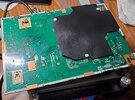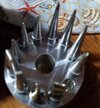Be gentle with me. I'm trying to remove and replace two caps on a circuit board. I'm using a rework station underneath to warm it to 200c and using a weller iron at 650. I've tried several different tips. Flat and conical. Flux on the older solder. The tips new, and/or tinned. Even with fresh solder in the hopes of getting the old solder wicked up or sucked up. Any tips or tricks are greatly appreciated.
Best regards,
Chris
Best regards,
Chris



